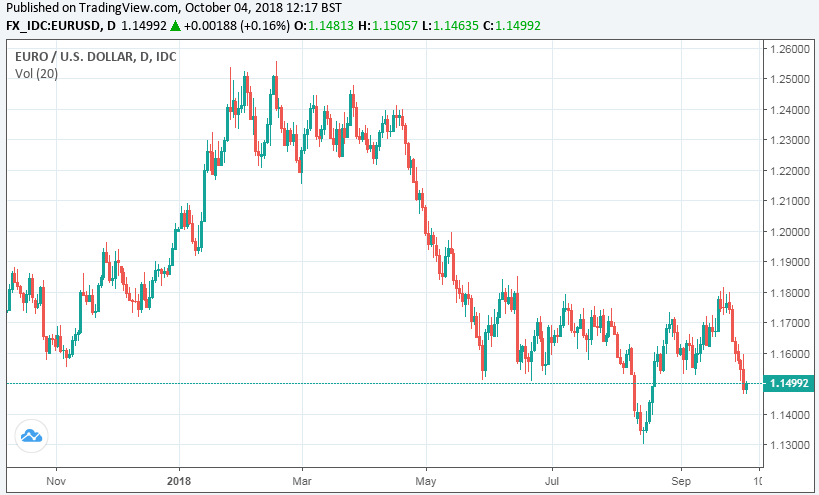Euro-to-Dollar Rate Breaks Below Key Support and is Headed for More Losses say Multiple Analysts
- Written by: James Skinner

© Christian Müller, Adobe Stock
The Euro fell back to its September lows against the Dollar Thursday after Federal Reserve (Fed) chairman Jerome Powell appeared to hint interest rates could rise higher than many give the central bank credit for.
Powell told an audience at The Atlantic Festival that U.S. interest rates are still a "long way" off from the so-called neutral level, which is the point at which monetary policy becomes neither stimulative nor a burden on the economy.
He also said the Federal Funds rate could move beyond this neutral level, which is estimated to be between 2.5% and 3%.
"Interest rates are still acommodative, but we're gradually moving to a place where they will be neutral," Powell said in discussion with Judy Woodruff of PBS NewsHour. "We may go past neutral, but we're a long way from neutral at this point, probably."
Powell's comments prompted a renewed sell-off in American bond markets, which pushed the 10-year Treasury yield to a seven-year high above 3.2% Thursday, drawing a fresh bid for the U.S. Dollar. Investors must buy the Dollar in order to benefit from the higher rates now on offer in the U.S. bond market.
This forced the Euro-to-Dollar rate below a crucial level of support located around 1.1510. Analysts had been watching the exchange rate closely to see whether it would avoid a break below that point and now the exchange rate has moved beneath it, some are warning of further losses to come.
"EUR/USD is on the defensive and has eroded the 1.1510/08 key support. This de stabilises the chart and allows for losses to 1.1411, the 78.6% retracement. This is seen as the last defence for the 1.1330 200 week moving average and the 1.1301 recent low," says Karen Jones, head of technical analysis at Commerzbank.

Above: Euro-to-Dollar rate shown at daily intervals.
Advertisement
Get up to 5% more foreign exchange by using a specialist provider to get closer to the real market rate and avoid the gaping spreads charged by your bank when providing currency. Learn more here
More Losses are Ahead
Jones says the "Elliot Wave count" is still flagging the Euro-to-Dollar rate decline as a "corrective" move lower that will soon be reversed but notes that the market is likely to decline all the way down to 1.1411 before it gains the momentum to stage a recovery.
"On the one hand we have rising yields and thus a rising yield curve as well as amazing economic data (ADP index well above market expectations) in the US. On the other hand we have a lack of confidence of the market in the promises of the Italian government that the budget deficit will be smaller as of 2020 and that debt levels will fall. This leads to EUR-USD below 1.15," says Antje Praefcke, a fundamental analyst and colleague of Jones at Commerzbank.
Praefcke says the EUR/USD rate is likely to remain below 1.15 "for now" because the U.S. Dollar is just too strong while the Euro remains beset by political problems.
America's Dollar is now up close to 4% for 2018 after having completely reversed what was once a 4% first-quarter decline.
Superior growth that has enabled the Fed to go on raising interest rates as other central banks sit on their hands has been the Dollar's greatest champion.
Powell's comments followed behind Septembers ISM non-manufacturing PMI, which measures activity and optimism among U.S. services companies.
"Yesterday's record 62.4 reading for the ISM employment component would ‘imply' a 500k increase in private sector jobs, which would be the best since 1983," says Kit Juckes, chief FX strategist at Societe Generale. "The underlying message is that the US economy isn't just in fine fettle, it's on fire."
The ISM index rose to its highest level since the late 1990's in September as order books swelled and hiring in the sector surged. That further reinforced the analysts' upbeat views of the U.S. economic outlook.
Judging from the market reaction, investors appear to have taken a new message about rates from Wednesday's events. One that points to interest rates moving higher over coming years than they otherwise might have.
"After the initial buying yesterday sub 1.1550, overnight we have seen good sellers sub 1.15 – but as rates market seemed to recover this morning, there might be some room for recovery in the pair - closer to 1.1550 it might be worth
considering a fade again," says a note from the UBS FX spot desk, suggesting selling into any recovery of the Euro-to-Dollar rate.
Advertisement
Get up to 5% more foreign exchange by using a specialist provider to get closer to the real market rate and avoid the gaping spreads charged by your bank when providing currency. Learn more here
Italian Budget Drama Adds to Euro Woes
The Euro has been rocked in recent weeks by a renewed confrontation between Italy and the EU over the former's 2019 budget plans.
Italy's government is widely reported to be planning a 2019 fiscal programme that would see it run a budget deficit equal to 2.4% of GDP, assuming the administration's economic growth forecasts do prove too optimistic.
This is a problem because Italy is in breach of the rules set out in the Maastricht Treaty, which forbid budget deficits in excess of 3% of GDP and national debt of more than 60% of GDP.
Italy had a budget deficit equal to 2.3% of GDP in 2017 and national debt in excess of 130% of GDP. It has until October 15 to present its final budget plan to the EU Commission for approval.
The preventative arm of the Stability and Growth Pact gives the European Commission powers to impose medium-term budgetary objectives on member states, in other words budget targets, and when those are not met the Commission can then initiate and Excessive Deficit Procedure.
Italy's medium term targets require an annual reduction in the deficit that is equal to at least 0.5% of GDP. While the exact budgetary black hole for 2018 is not yet know, plans for a 2.4% deficit in 2019 are sure to put the country in breach of the requirements.
Accordingly, the European Commission is within its rights to demand more austerity from Italy and could eventually fine the government for non-compliance. This risks stoking anti-Euro sentiments in Italy, placing a question mark over its position as a member of the single currency bloc.
Advertisement
Get up to 5% more foreign exchange by using a specialist provider to get closer to the real market rate and avoid the gaping spreads charged by your bank when providing currency. Learn more here




